Report of New Macrolichens for the State of Ohio
Tomás J. Curtis
tcurti12@kent.edu
Introduction
During the late months of 2017 through 2018 many noteworthy lichen records were found in Ohio. Macrolichens continued to be collected and identified as part of an ongoing study of Ohio lichens by the author. Here each macrolichen species new for the state of Ohio will be discussed individually. These new species include Heppia adglutinata, Hypotrachyna revoluta, Melanelixia glabratula, Multiclavula corynoides, Tuckermanopsis sepincola, Usnea glabrata and Usnea subgracilis.
Materials and Methods
Lichens were found and collected by the author at various sites throughout Ohio. Specimens cited below, as well as all the specimens related to this broader study, have been deposited at the Kent State University Herbarium (KE). They were examined using both a Stereomaster dissecting microscope and a Nikon Asphaphot-2 YS2 compound microscope. Standard spot tests were performed as well as thin-layer chromatography to study the metabolic biproducts that lichens often produce. Lichens were identified using Lendemer, J., Harris, R., and Tripp, E. (2013), Hinds, J. and Hinds, P. (2007), and Brodo, I. (2016).
NEW MACROLICHENS FOR OHIO
Heppia adglutinata (Krempelh.) A. Massal.
Heppia adglutinata is a small terricolous cyanolichen in the family Heppiaceae. It has an olive to brown squamulose to peltate thallus and large red-brown immersed apothecia that generally develop singly in the center of a squamule. Its distribution includes most of the United States, from around the Great lakes and Northeastern United States to the Southwest. Despite having a broad range, it appears to be infrequent and rarely collected. In February of 2018, a population of Heppia adglutinata was located by the author at Castalia Quarry Metroparks in Erie County, Ohio. It was a robust but isolated population growing on calcareous soil in the open quarry and associated with Placidium squamulosum.
Specimen examined – U.S.A. OHIO. ERIE CO.: Castalia Quarry Metro Park, in quarry, 17 February 2018, on exposed calcareous soil, Tomás J. Curtis (KE).
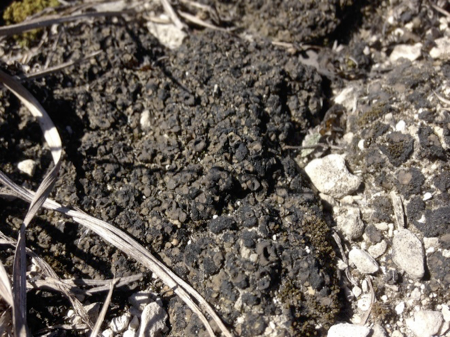
Heppia adglutinata. Photo by Tomás Curtis
Hypotrachyna revoluta (Flörke) Hale
Hypotrachyna revoluta is a medium-sized foliose lichen with loosely adnate lobes that become revolute and produce farinose soredia. The thallus is gray to green-gray and smooth with a faintly maculate to emaculate surface and a black undersurface. In the Eastern United States, this species is infrequent in the extreme northeast, around Lake Superior, and throughout the Southern and Central Appalachians. In January of 2018, a single thallus of Hypotrachyna revoluta was located by the author near Mohican Memorial State Forest in Ashland County, Ohio, near the dam of Pleasant Hill Lake. It was growing on a branch of Acer rubrum in a developed area near a parking lot. Almost a month later, a second thallus was found in an adjacent county at the Simco Wildlife Area. These Ohio locations are quite disjunct from other known records.
Specimens examined – U.S.A. OHIO. ASHLAND CO.: near Mohican Memorial State Forest, next to the Pleasant Hill Lake dam along County Road 3006, 11 January 2018, on branch of Acer rubrum, Tomás J. Curtis (KE). U.S.A. OHIO. COSHOCTON CO.: Simco Wildlife Area, near Township Road 280, 9 February 2018, on bark of Alnus glutinosa. Tomás J. Curtis (KE).
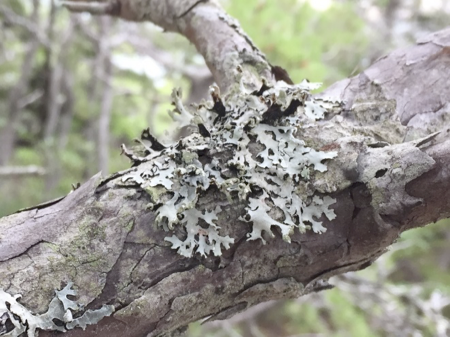
Hypotrachyna revoluta. Photo by Tomás Curtis
Melanelixia glabratula (Lamy) Sandler Berlin & Arup
Melanelixia glabratula is an olive-brown to reddish-brown medium-sized foliose lichen with an adnate, pseudocyphellate thallus that produces relatively long, branched isidia. It is common throughout the Appalachians and the Pacific Northwest but also occurs scattered around the Great Lakes. In June of 2018, it was located by the author during the 2018 OMLA Summer Foray in Wayne County, Ohio near Kister Fen. It was found growing on an old sun-exposed wooden fence in a yard and associated with other uncommon and often lignicolous species such as Calicium tigillare and Caloplaca microphyllina.
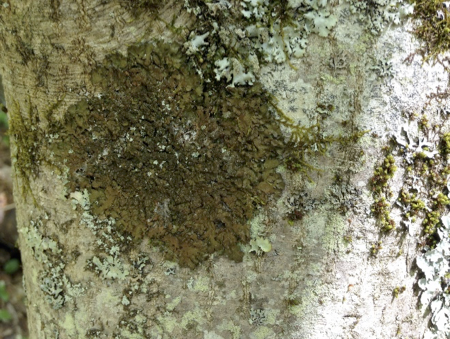
Melanelixia glabratula. Photo by Tomás Curtis
Specimen examined – U.S.A. OHIO. WAYNE CO.: in yard just east of intersection between Kister Rd. and Willow Rd., close to Kister Fen, 9 June 2018, on a wooden fence rail, Tomás J. Curtis (KE).
Multiclavula corynoides (Peck) R. Petersen
Multiclavula corynoides is one of a small number of lichenized basidiomycete fungi that derive nutrients from green algae that have been incorporated into their tissue. The colonies grow on algal films over moist exposed soil, and the fruiting structures are erect, orange to pale orange-buff clubs that are often scattered within the algal film. It is represented by only two collections in the Eastern United States and is probably rare throughout its range, though collection bias may contribute towards this lack of representation. In June of 2018, Multiclavula corynoides was found by the author at Shaw Woods in Portage County, Ohio. It was growing in a large open power-line right-of-way over moist algae-covered soil and associated with species of Dichanthelium, Danthonia, Rubus, and moss.
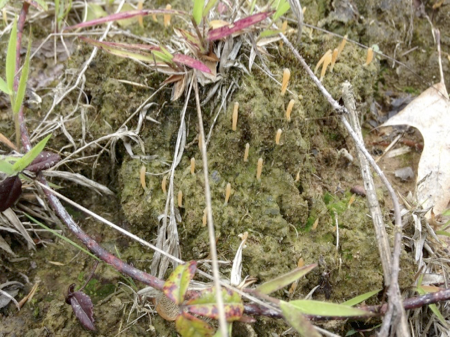
Multiclavula corynoides. Photo by Tomás Curtis
Specimen examined – U.S.A. OHIO. PORTAGE CO. Shaw Woods (Portage Park District property), in the power line right-of-way, 7 June 2018, on exposed acidic soil with a superficial algal film, Tomás J. Curtis (KE).
Tuckermanopsis sepincola (Ehrh.) Hale
Tuckermanopsis sepincola is a small olive-brown to ashy-brown foliose lichen with raised lobes that often produce apothecia on the tip of the upper surface. The apothecia often become so abundant that the thallus is obscured beneath them. It is common north of the Great Lakes and through the Appalachians on branches and twigs of acidic shrubs and trees in open areas. In August of 2017, a single thallus of Tuckermanopsis sepincola was located at Towner’s Woods in Portage County, Ohio. It was growing on a twig of Chamaedaphne calyculata in a small Chamaedaphne bog surrounded by forest.
Specimen examined – U.S.A. OHIO. PORTAGE CO. Towner’s Woods (Portage Park District Property), 20 August 2017, on a Chamaedaphne calyculata twig, Tomás J. Curtis (KE).
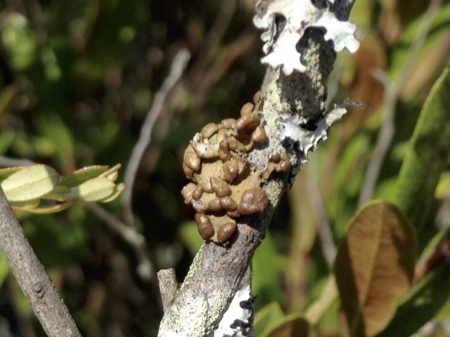
Tuckermanopsis sepincola. Photo by Tomás Curtis
Usnea glabrata (Ach.) Vain.
Usnea glabrata is a small, shrubby, fruticose lichen with inflated branches that narrow at the base. The terminal branches usually produce large and often excavate soralia that lack isidiomorphs. These physical characteristics, combined with the production of protocetraric and fumarprotocetraric acid in the medulla, are diagnostic for this species. Known primarily from the West Coast, Usnea glabrata is known from Eastern/Central North America only by a handful of records from the Southern Appalachians and from above Lake Superior.
In December of 2017, a single thallus of this species was collected by the author at West Branch State Park in Portage County, Ohio. Fitting the physical description, the author brought the specimen to the 2018 Tuckerman Workshop for thin-layer chromatography to be performed by Dr. James C. Lendemer and the identification confirmed.
Specimen examined – U.S.A. Ohio. PORTAGE CO.: West Branch State Park, 9 December 2017, on a fallen Fraxinus tree branch, Tomás J. Curtis (KE).
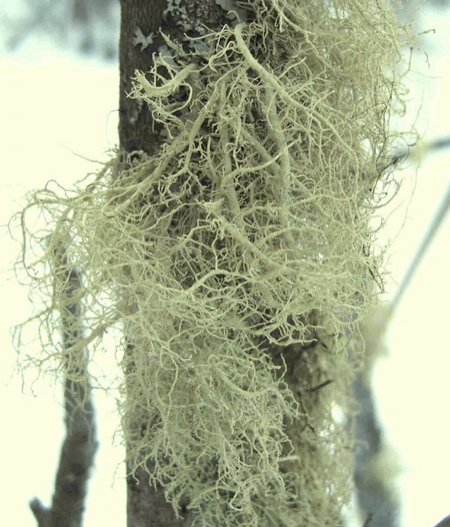
Usnea glabrata. Photo by Curtis Björk
Usnea subgracilis Vain.
Usnea subgracilis is a light-green pendulous fruticose lichen with thin, smooth branches that produce small soralia towards the end and usually lack papillae and isidiomorphs. In Eastern North America, it is common in the Southern and Central Appalachians and in Nova Scotia, New Brunswick, and New England.
In April of 2018, a single thallus was located at the Grand River Wildlife Area in Trumbull County, Ohio. It was found growing on smooth bark of a young Acer rubrum at the edge of a small wetland. The identification was confirmed by Dr. James C. Lendemer using thin-layer chromatography.
Specimen examined – U.S.A. OHIO. TRUMBULL CO. Grand River Wildlife Area, near shooting range on OH-88, 6 April 2018, on smooth bark of a young Acer rubrum, Tomás J. Curtis (KE).

Usnea subgracilis. Photo by Tomás Curtis
Discussion
Though the distributions of most lichen species are fairly well known, lichens never cease to surprise scientists with the disjunct records that are regularly found. Each species presented here represents a single record or a small cluster of records amid vast gaps in their range. Though not all these new records are necessarily surprising, each represents an extension of the range of a lichen. There are certainly other species of lichens waiting to be found throughout Ohio – a testament to the complexity and illusive nature of lichenized fungi.
Acknowledgments
I would like to give special thanks to Dr. James Lendemer, Ray Showman, Dr. Barbara Andreas, and any others who helped mentor me through my studies.
General References
Andreas, B.K., R.E. Showman and J.C. Lendemer. 2007. The 2006 combined Crum/Tuckerman Workshop in Ohio. Evansia.
Brodo, I. (2016). Keys to Lichens of North America. Ottawa, Ontario: Canadian Museum of Nature
Esslinger, T. L. A Cumulative Checklist for the Lichen-forming, Lichenicolous and Allied Fungi of the Continental United States and Canada, Version 22. North Dakota State University.
Hinds, J. and Hinds, P. (2007). The Macrolichens of New England. Bronx, NY: The New York Botanical Garden Press.
Lendemer, J., Harris, R., and Tripp, E. (2013). The Lichens and Allied Fungi of the Great Smoky Mountains National Park. Bronx, NY: The New York Botanical Garden Press.
Nash, T.H., Ryan, B.D., Gries, C., Bungartz, F., (eds.) 2002. Lichen Flora of the Greater Sonoran Desert Region. Vol 1.
Ohio Moss and Lichen Association 2018. A List of the Lichens of THE GREAT STATE OF OHIO
Showman, R. E. and Flenniken, D. 2004. The Macrolichens of Ohio. Columbus, OH: Ohio Biological Survey.
Showman, R. E. and Flenniken, D. 2008. UPDATES AND CORRECTIONS to The Macrolichens of Ohio. Ohio Moss and Lichen Association.
(published in OBELISK, Vol. 15, p. 2-6)
